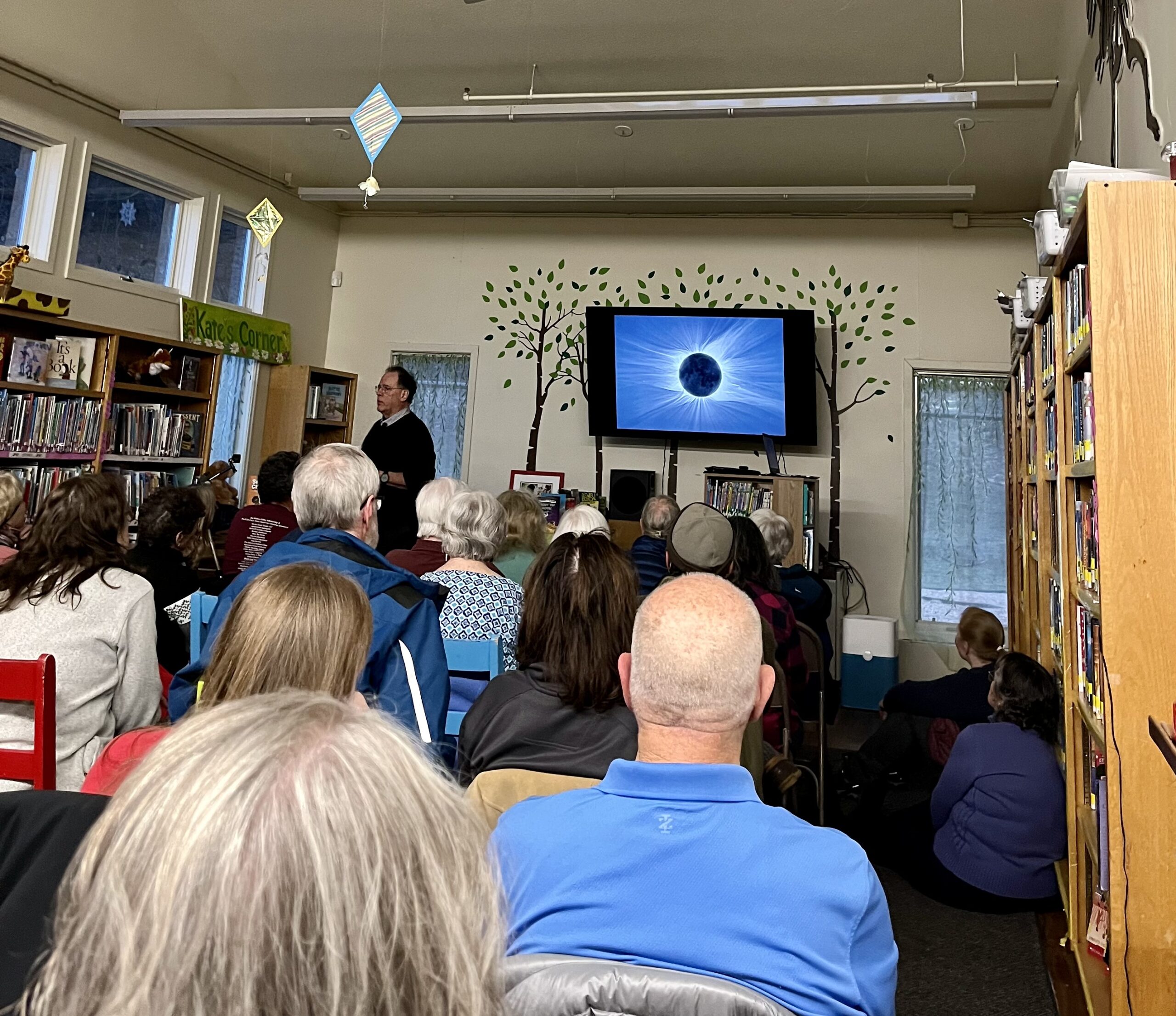PROCTORSVILLE, Vt. – The audience was standing room only on Tuesday, March 19, at the Cavendish Fletcher Community Library in Proctorsville. The crowd had gathered for the Eclipse 2024 presentation, given by astronomer Claudio Véliz, and sponsored by the Cavendish Community and Conservation Association (CCCA).

A former astrophysics professor at Columbia University, Véliz has worked with NASA and the Hayden Planetarium, and was excited to dive into his presentation on Vermont’s potential front row seat to the April 8 solar eclipse. Véliz covered the origin of eclipses, how and why they occur, the dos and don’ts of viewing an eclipse, and where the optimal viewing locations will be – the path of totality.
As many Vermonters are aware, that path is going to be in the northern part of our state. “Anywhere north of Middlebury, basically,” Véliz said. About one-third of those in attendance raised their hands when Véliz asked who planned to travel north.
Véliz began by explaining that we have solar eclipses because of the moon’s orbital plane, which is tilted about 5 degrees compared to Earth’s orbit around the sun. Because of this, we on Earth see the moon as it passes above or below the sun, as it travels between us and the sun. The eclipse is the Moon’s shadow on Earth.
Many attendees were obvious astronomy aficionados, and there was a lot of enthusiastic energy in the packed library, with many good questions asked of Véliz. One important safety tip he offered is that wearing protective eyeglasses during the time leading up to and immediately after the total eclipse is vitally important. Regular sunglasses do not offer enough protection, the sun’s ultraviolet rays will damage your eyes.
Additionally, the protective shield should be placed in front of the optics – binoculars, a telescope – and not the other way around.
Véliz confirmed that #14 welders’ glasses would also work.
Regarding viewing the eclipse, Véliz encouraged keeping the viewing optics still, which makes a huge difference in the clarity of the image.
Véliz reported that another event will occur during the eclipse, a massive comet, 12P/Pons-Brooks – or the “devil comet,” so named because of the appearance of two “horns” of explosive gas and ice – will be making a rare appearance in the sky.
“Also, Venus, Jupiter, and a whole bunch of bright stars will be visible,” stated Véliz.
Historically, as eclipse followers are aware, there is a high chance of clouds on April 8. Véliz remarked, “Veterans know to remain mobile.”
For people planning to travel north for an optimal viewing experience, Véliz suggested making alternate plans, just in case. But, he added, “regardless of weather, the experience is a lot more fun to do with a group.”
Véliz announced that a new, hydrogen-alpha filter solar telescope will be set up on Hoisington Field in Perkinsville during the afternoon of April 8, roughly from 2-4:30 p.m. The Southern Vermont Astronomy Group (SoVerA) had worked with the Weathersfield Proctor Library and the Reading Public Library to receive a $5,000 grant and purchase the telescope. The hydrogen-alpha filter allows for extremely clear images not possible with less expensive viewers.
The total eclipse will occur around 3:30 p.m., depending on exact location, and the full eclipse will last about 3 ½ minutes.
In Cavendish, the eclipse will happen at 3:26 p.m., with 98% obscuration expected in the area. Temperatures can drop 10-15 degrees, and the eerie feeling of total darkness in the middle of the afternoon can be unsettling.
Véliz reported, “During the 70-80 minutes leading up to, and after the total eclipse, many people will tear up. It can be a powerful feeling, and it affects all of us differently.”
“If you have animals, like chickens, observe them,” Véliz suggested. “They will behave strangely.”
Véliz offered some hope if our weather doesn’t cooperate, and we are denied the experience of watching a total solar eclipse from our backyard. He told the audience there are two to three, or as many as six solar eclipses per year. In the years between 2028-2038, there will be five eclipses in Australia and New Zealand, and Véliz advised that attendees start planning to travel there for at least one of them.
More information on the solar eclipse can be found at: